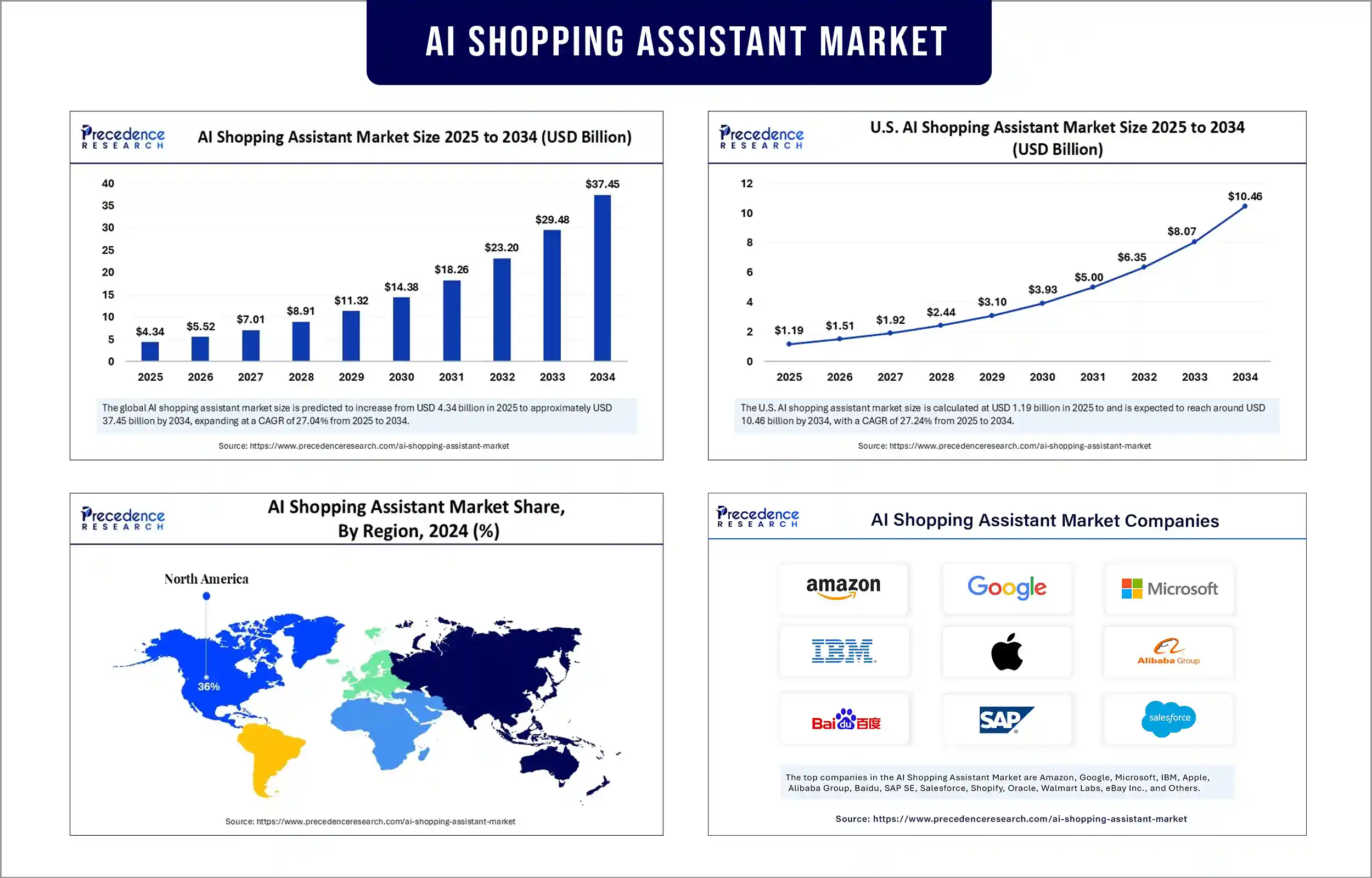AI Shopping Assistant Market Revenue to Attain USD 29.48 Bn by 2033
AI Shopping Assistant Market Revenue and Trends 2025 to 2033
The global AI shopping assistant market revenue is valued at USD 4.34 billion in 2025 and is expected to attain around USD 29.48 billion by 2033, growing at a CAGR of 27.04% during forecast period. The market growth is driven by the increasing demand for personalized, seamless, and data-driven shopping experiences across digital and mobile platforms.

What are the Key Factors Driving the Growth of the AI Shopping Assistant Market?
The market is experiencing rapid growth, driven by technological advances and changing consumer expectations. The ongoing adoption of artificial intelligence, natural language processing, and machine learning leads to highly personalized shopping experiences, increased customer engagement, and higher conversion rates. The push for omnichannel retail and the rise of e-commerce have created a pressing need for retailers to find AI tools that can ease product discovery, offer price comparisons, and generate purchase recommendations. The growing adoption of smartphones and the rising integration of retail with voice assistants such as Alexa and Google Assistant are expected to sustain market growth in the coming years. AI assistants provide valuable functional tools to retailers, allowing them to reduce operational costs, enhance customer service, improve efficiency, and gain value from shopping behavior data, making them a vital tool in the retail sector.
Segment Insights
- By technology type, the natural language processing (NLP) segment dominated the market in 2024, as it is the backbone of human-AI interaction in commerce. It enables intuitive, conversational, and highly personalized retail experiences.
- By device integration, the smartphones & tablets segment dominated the market in 2024, as these devices facilitate the easy integration of AI solutions. The rising demand for personal shopping experiences and increasing need for customers engagement further contribute to segmental growth.
- By application, the product discovery & search segment led the market in 2024, due to its crucial role in empowering users with quick, accurate, and personalized shopping recommendations. It helps consumers find the right products quickly, accurately, and intuitively.
- By end-user, the e-commerce platforms segment led the market in 2024, as these platforms were the primary battleground for digital shopping. E-commerce platforms leverage AI to make online buying easier and more enjoyable.
- By retail format, the online segment dominated the market in 2024 because online platforms provided the ideal environment for deploying, scaling, and optimizing AI-driven experiences, especially as digital commerce became more mainstream and competitive. AI speeds up shopping experiences in a personalized, convenient, and data driven nature for worldwide consumers.
- By deployment mode, the cloud-based segment led the market in 2024, as it provided the scalability, flexibility, real-time processing, and cost-efficiency that businesses needed to deploy AI solutions quickly and effectively.
Regional Insights
North America held a significant share of the AI shopping assistant market in 2024. This is mainly due to its robust technological infrastructure and high consumer preference for digital shopping. The presence of major e-commerce companies in the region, alongside rapid adoption of AI-driven tools, bolstered market growth. There is a high demand for omnichannel retail options and voice-powered shopping experiences is further anticipated to boost the adoption of AI shopping assistant platforms and solutions. Moreover, substantial investments in AI research & development in North America, particularly in the U.S., position the region as a leader in the evolution of AI-driven retail solutions.
Asia Pacific is expected to grow at the fastest rate in the coming years. The rise of e-commerce and rising popularity of online shopping are major factors boosting the growth of the market. China, India, and Japan are major players in the market due to rising demand for AI-driven product recommendations. With the emergence of a mobile-first consumer and super apps that integrate AI-enhanced shopping functionality, there is enormous potential for transformation in shopping assistants in real-time. Rising government efforts to integrate AI in every sector further contributes to regional market growth.
AI Shopping Assistant Market Coverage
| Report Attribute | Key Statistics |
| Market Revenue in 2025 | USD 4.34 Billion |
| Market Revenue by 2033 | USD 29.48 Billion |
| CAGR from 2025 to 2033 | 27.04% |
| Quantitative Units | Revenue in USD million/billion, Volume in units |
| Largest Market | North America |
| Base Year | 2024 |
| Regions Covered | North America, Europe, Asia-Pacific, Latin America, and Middle East & Africa |
Recent Development
- On July 24, 2025, Walmart launched a suite of AI-powered "super agents" using agentic AI, including Sparky for personalized customer shopping and agents for employees (Associate), suppliers/advertisers (Marty), and developers (Developer). This initiative supports Walmart’s push to grow e-commerce to 50% of total revenue. (Source: https://timesofindia.indiatimes.com)
AI Shopping Assistant Market Key Players
- Amazon
- Microsoft
- IBM
- Apple
- Alibaba Group
- Baidu
- SAP SE
- Salesforce
- Shopify
- Oracle
- Walmart Labs
- eBay Inc.
- Pinterest (Shopping Lens)
- Clarifai
- ViSenze
- Syte AI
- Vue.ai
- TrueFit
- Farfetch
Get this report to explore global market size, share, CAGR, and trends, featuring detailed segmental analysis and an insightful competitive landscape overview @ https://www.precedenceresearch.com/sample/6584
You can place an order or ask any questions, please feel free to contact at sales@precedenceresearch.com |+1 804 441 9344